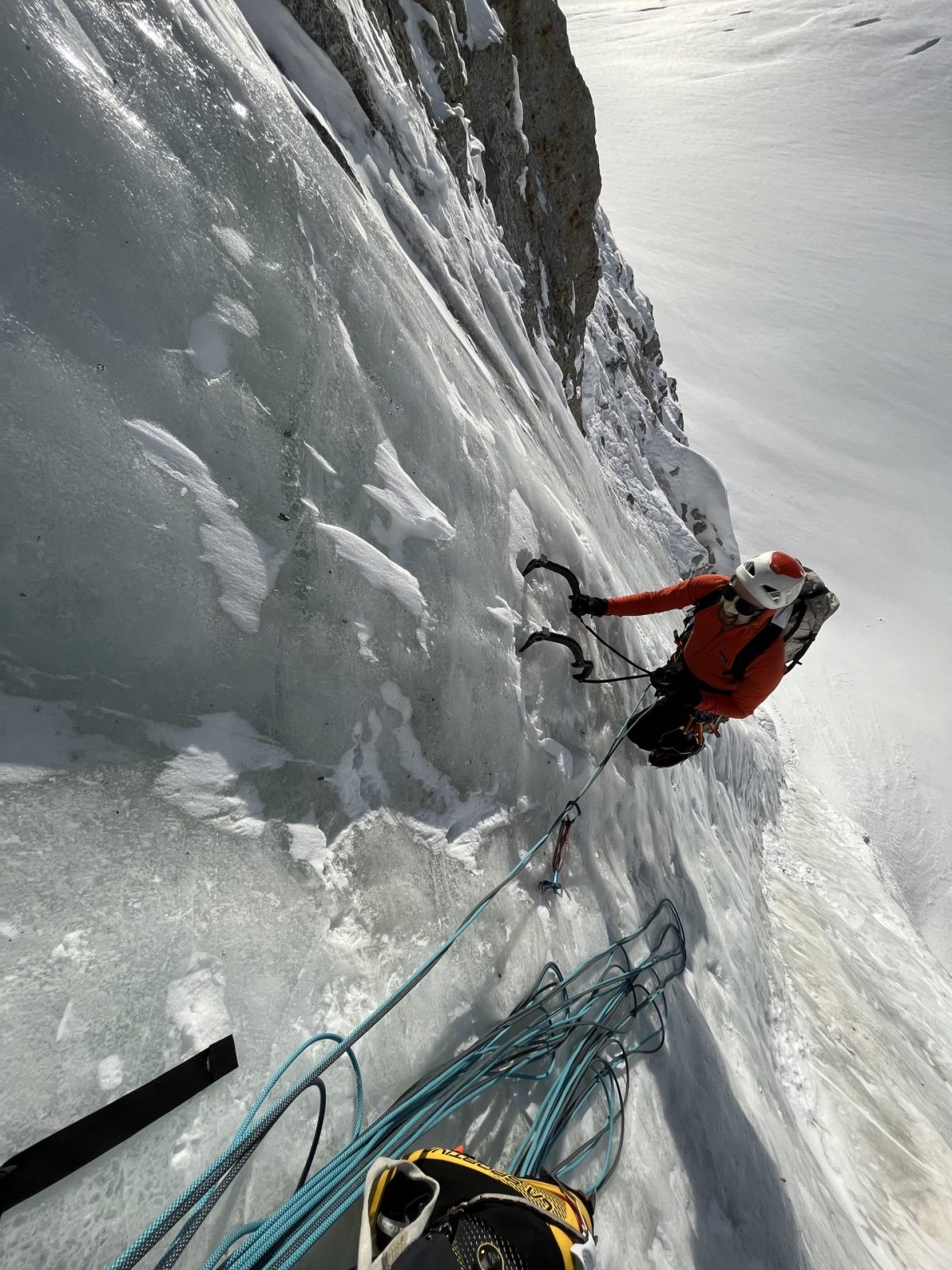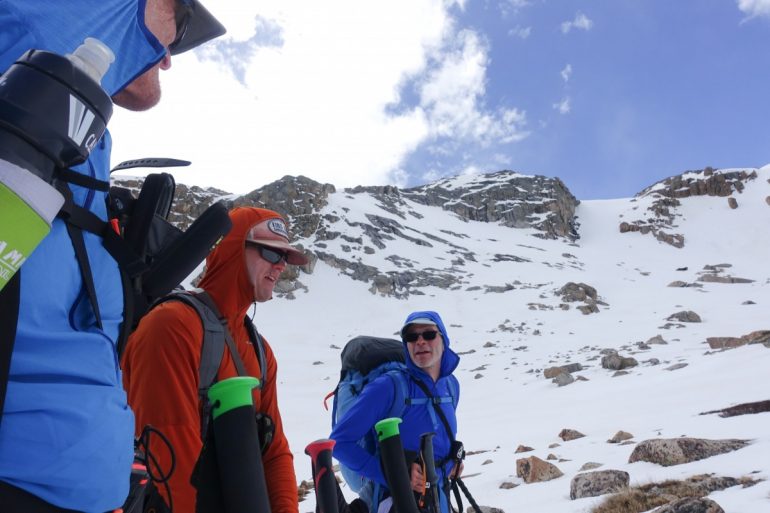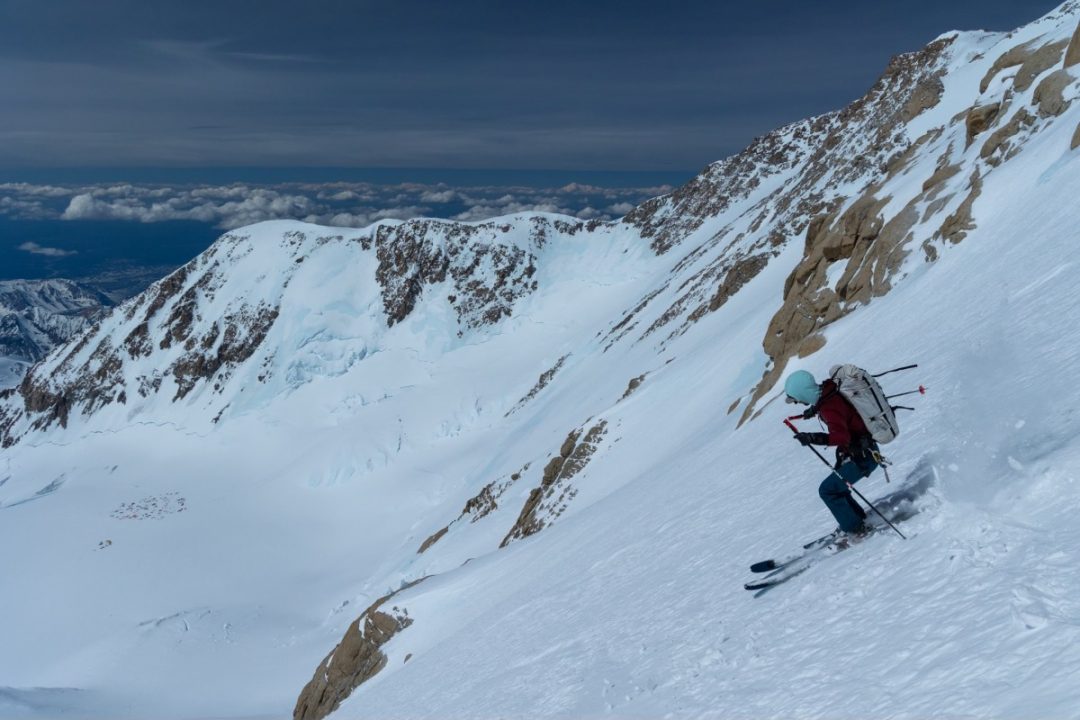Part one of this two-part series explored gear recalls in the backcountry ski/ride community, emphasizing avy beacons. In part two, we dive into former BD CEO Peter Metcalf’s experience leading a gear manufacturer and his thoughts on the current climate of designing and manufacturing personal protective equipment (PPE).

Artem Vasilyev on Bacon & Eggs: a route ascending the the Mini Mini Moonflower, Denali National Park. Photo: Aidan Whitelaw.
Sinking his axes in and stepping up, Jeff Jamison ascends a frozen waterfall. There’s the solid feeling of pick sunk in ice, one after the other, a confidence-inspiring sensation drawing him upwards on his solo climb. Near the top, one of Jamison’s ice axes, a Black Diamond Equipment Black Prophet, snaps. Left with a single functional tool and loads of moxy, Jamison downclimbs to safety.
This incident occurred in January of 1993. Five years later, a lucid analysis of how Black Diamond Equipment dealt internally with this gear failure, titled “Black Diamond Ltd.: Hanging on the Cutting Edge,” was published. In it, we learn that problem solving when it comes to failed equipment and developing a plan to move forward is complex. It is, simplistically reduced, a process of going back in time to determine what went wrong between initial product ideation and development to manufacturing and, ultimately, field use. The Black Prophet case study, one of the authors, Mellie Pullman, wrote in an email, is “set up as a teaching case for strategy or quality classes,” not a best or worst practices how-to.
Black Diamond had yet to release the Black Prophets to the general public when Jamison’s axe failed. However, several ice climbers in the community were using the tools. In “Hanging on the Cutting Edge,” the authors explain that the next phase of production and shipping had proceeded: “with all the excitement over the new design, preseason orders for the Black Prophet had exceeded expectations,” they explained. “Although the tool was on back order for many customers, the first production run of the axe had already been shipped to mountaineering stores throughout the world.”
Compared to an avalanche beacon, an ice tool is relatively low-tech. There are no electronics or switches to malfunction and render key functions, like locking in “send” mode, useless. In ice climbing, a faulty ice tool, especially one prone to catastrophic failure, can mean a potential, if not a likely, death sentence.
The Black Prophet was innovative. They were an ice climbing-specific axe with an ergonomic rubberized grip, modular picks, hammer, adze, and composite shaft. I can attest to the marketplace’s buzz; we coveted these tools. And as a leader in climbing innovation, Black Diamond was eager to push the project forward.
In their case study, the authors document some of the internal discussions between the then BD CEO Peter Metcalf and other company leaders as they explore BD’s potential financial and legal vulnerabilities and how to protect its reputation. The axe failure occurred on the weekend. By Monday morning, crisis management and damage control began.
“As the Monday morning meeting continued, Black Diamond’s top management team struggled to find answers to the questions raised by the axe crisis. They knew that the situation required both short- and long-term solutions. In the short term, management needed to address the pressure for immediate delivery confronting customer service. Should management recall all the Black Prophet axes currently on the market? A recall would come with high shipping, testing, and opportunity costs. Or should Black Diamond basically ignore the incident, assuming the accident was a one-time freak, and continue to sell the axes while refuting any rumors about the axe’s questionable performance? The possibility of lawsuits had to be considered.”

Artem Vasilyev sets up for his lead on Bacon and Eggs. The focus remains on covering ground, not on the reliability of the gear. Photo: Aidan Whitelaw.
***
In speaking with Metcalf for this story, he recalled thinking at the time, “what decision do you make? Is it really defective? Or were there a couple of defective tools? Those are some of the things you’re trying to figure out. Do you have to bring everything back or not? And in that case [with the Black Prophet], we brought everything back in the end.”
Metcalf and its employees took over Black Diamond at a time of turmoil. The ’80s, Metcalf said, was a Big Bang type era for the industry with rapid growth in users and sales and a considerable diversification of products. These business dynamics, said Metcalf, coincided with an increase in personal liability lawsuits against land managers and gear manufacturers for the “failure to warn” about potential risks.
To counter this, companies like BD sought norms and standards for their climbing and backcountry ski gear, including proper warnings on specific items and more stringent production and materials oversight. Part of those advancements, beyond the good intentions of outdoor industry stakeholders, was creating better protections for gear manufacturers against frivolous lawsuits.
“Once you have the standards and warnings, you hopefully have created some significant barriers for a plaintiff’s attorney to leap over. They can’t attack you for saying you didn’t know standards, you don’t have quality control documentation, you don’t have quality assurance, or the labeling isn’t there,” said Metcalf. “We had all of that. And it was industry adopted, and it was now what they had in Europe.”
Dealing with the fallout from a poorly executed recall, flawed messaging, or even the appearance of feigning concern has negative implications beyond quarterly profit forecasts; it can tarnish a company’s reputation among its core users.
***
When Metcalf and employees of Chouinard Equipment formed BD, the corporate landscape was different; outdoor gear manufacturers weren’t considered investments for venture capitalists or private equity firms.
Backcountry Access (BCA), referenced in part one of this series, was purchased by K2 Sports in 2013. K2 Sports, a much larger fish than BCA, was then eyed and purchased by Newell Brands, an international consumer goods company that owns Rubbermaid, Elmer’s glue, and Marmot as part of its extensive subsidiary portfolio. Another fish swam along in 2017: the New York private equity firm Kohlberg & Co., who acquired K2 Sports and, as part of the deal, BCA.
Anecdotally, BCA appears to have maintained a semblance of autonomy as it morphed from a grassroots Boulder, CO, business to an enticing corporate investment opportunity. “Even under K2, Jarden, and Newell’s watch, we’ve maintained our own location, customer service, sales, marketing, product development and culture,” BCA founder Bruce Edgerly told The Denver Post in 2017 during the Kohlberg & Co., acquisition. “We’re still backcountry skiers at heart and happy to be ‘outliers’ in the organization — so we can continue to focus on what we love about this industry: chasing powder and saving lives.”

Kelly Cordes (right) and Brian Parker (middle) wear beacons on their chest and assume, rain or shine, or worst case scenario, the beacons will function properly.
Black Diamond Equipment was still under Metcalf’s leadership in 2010 when it sold to Clarus Corporation, which is listed on the Nasdaq. Clarus is Salt Lake City based and still owns BD. Its website states it is “a global leading designer, developer, manufacturer and distributor of best-in-class outdoor equipment and lifestyle products focused on the outdoor and consumer enthusiast markets.”
One can not understate BD’s exposure to potentially flawed designs and manufacturing processes as a manufacturer of climbing softgoods, hardware, and snow safety equipment. Metcalf, who ran BD from 1989 until 2015, witnessed firsthand the cultural evolution of the outdoor equipment industry. His lengthy stint with BD began initially with Chouinard Equipment; Metcalf understood the iconography and mythology of Chouinard blacksmithing and pounding away on an anvil crafting pitons. The end-users of the gear were also the designers, manufacturers, marketers, and salesforce.
At BD, before its sale in 2010, and undoubtedly true today to a certain extent, corporate culture was defined by few degrees of separation between end-users and employees. Metcalf said the employees created BD to serve a specific community, climbers and skiers. And the employees and upper management were indistinguishable from that community. “This is our community; this is us,” Metcalf said about BD’s core customers and the obligation to safety. “They are our best friends. It’s our climbing and ski partners. It’s our parents, our children, our brothers, and sisters. We didn’t want to see ourselves and brothers, our employees, and family hurt.”
“I will say this about my tenure at Black Diamond, I don’t think that we ever failed to make the right call,” continued Metcalf. “Sometimes we had to wait a little bit of time to figure out what is the right call because you don’t necessarily want to do a recall of everything because it’s very expensive, and it sends the wrong message for some product if it’s actually working and there isn’t a need to do it. So it’s incumbent upon you to figure this out quickly.”
***
According to the analysis of the original Black Prophet ice axe failure, Metcalf immediately consulted with the key players involved with the axe’s development. Around the meeting table that Monday morning in 1993, Metcalf gathered with BD’s lead marketing manager, customer service manager, R&D manager, the Black Prophet’s lead designer, the production manager, and a newly appointed quality assurance manager. After some discussions, Metcalf asked the lead assembler, who had personally assembled each axe, to debrief the gathered stakeholders.
We see a rare glimpse into how a major outdoor gear manufacturer attempts to discover systematic design and/or production flaws through an informal fault-tree analysis. At a granular level, they discuss the axe as if it were a farm-to-table enterprise. Beyond determining causation, BD had what the authors of the analysis claim were BD’s short and long-term solutions to consider.
Short-term options on the table were:
—“Should management recall all the Black Prophet axes currently on the market?”
—“should Black Diamond basically ignore the incident, assuming the accident was a one-time freak, and continue to sell the axes while refuting any rumors about the axe’s questionable performance?”
—“continue the sale of Black Prophets—including the axes already released as well as those in production—but require all units to be sold with a cautionary label?”
—“should Black Diamond just quietly and quickly sell those Black Prophets already in retail outlets and only undertake a critical review of the axes still in production?”
BD ultimately had all the Black Prophets returned. And in the long-term, BD continued formalizing a quality assurance program. What Metcalf navigated then, and several other times during his tenure, rings true now.
“I think that whenever there is a case, that after you’ve analyzed it and you determine there is an issue of user safety, that somebody can get seriously hurt, or killed, then it is absolutely immoral, unethical, to do anything but recall the product and figure out how to replace, repair, trash, give the money back,” said Metcalf.
“In my 30 years, there were several recalls,” Metcalf added. “And what I will tell you is at the end of the day, of course, you look at the financial ramifications. But every time you do, you realize that if we don’t do this, the financial ramifications, separate from the ethical issues, will be much larger. Because if somebody gets killed or hurt, how can you sleep at night? And second, your insurance premiums will go through the roof, and your reputation will be trashed. I think climbers and skiers are much more forgiving of a company with the integrity to acknowledge and explain the mistake and recall the product quickly.”

Tucker Hoefler finds turns on Denali. A location requiring well-tested and reliable gear. Photo: Aidan Whitelaw.
Consumers have choices between brands and feature sets. Arva, BCA, Mammut, Ortovox, Pieps (including BD rebranded devices) are still in the avalanche transceiver business. Skiers and riders hope they are not choosing between beacon reliability and failure in an emergency scenario. What’s clear from simply using a modern beacon, or digesting BD’s interworkings during the Black Prophet ice axe crisis, is that product development and manufacturing are rife with many potential failure points. When a company manufactures and sells personal protective equipment (PPE) like an avalanche beacon, however, we expect near-perfect, if not perfect, execution: A beacon, for example, remains locked in “send” mode unless the user manually switches to “search.”
And if the unit is flawed, we’re likely all in consensus that doing the right thing requires not shareholder considerations but embracing Metcalf’s words: “This is our community, this is us.”
Jason Albert comes to WildSnow from Bend, Oregon. After growing up on the East Coast, he migrated from Montana to Colorado and settled in Oregon. Simple pleasures are quiet and long days touring. His gray hair might stem from his first Grand Traverse in 2000 when rented leather boots and 210cm skis were not the speed weapons he had hoped for. Jason survived the transition from free-heel kool-aid drinker to faster and lighter (think AT), and safer, are better.
